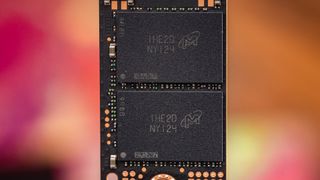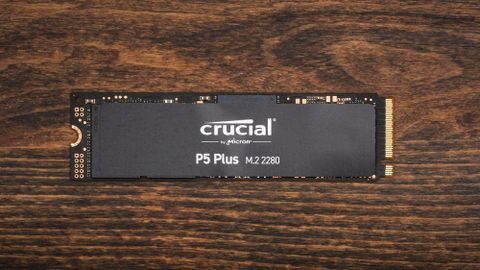Tom's Hardware Verdict
The 2TB Crucial P5 Plus sees minor performance gains thanks to twice the flash dies, but could use some work on its efficiency. Still, with overall solid performance, ultra-competitive pricing, and a solid feature set, the P5 Plus is a great value for those in search of a new PCIe Gen4 SSD.
Pros
- +
Competitive performance and price
- +
Hardware-based AES 256-bit encryption
- +
Attractive design
- +
Software package
- +
5-year warranty
Cons
- -
High idle power consumption
- -
Less-than-average efficiency under load
Why you can trust Tom's Hardware
November 10, 2021 Update: We've updated this article with new testing for the 2TB Crucial P5 Plus M.2 NVMe SSD on page 2.
Original Review published August 3, 2021:
We have had quite a few PCIe 4.0 x4 SSDs pass through our lab since we saw the first demo in early 2019, but none from the likes of Crucial, until now that is. Crucial’s P5 Plus marks the company’s first Gen4 SSD release, and it follows the company’s value over top-end performance agenda well, ranking it as a solid value for those looking for next-gen performance at prices below that of the competition.
While competitors are working on breaking the limits of current PCIe 4.0 capability, Crucial has decided to play things safe with the introduction of its new PCIe 4.0 NVMe SSD, optimizing it for specific workloads and reliability rather than trying to go for gold in all testing metrics. Only rated for speeds of up to 6.6 GBps, it’s not quite the bleeding-edge competitor we were expecting from such a large memory brand, but it’s a solid step in the right direction.
Specifications
| Product | 500GB | 1TB | 2TB |
|---|---|---|---|
| Pricing | 107.99 | 179.99 | 367.99 |
| Capacity (User / Raw) | 500GB / 512GB | 1000GB / 1024GB | 2000GB / 2048GB |
| Form Factor | M.2 2280 | M.2 2280 | M.2 2280 |
| Interface / Protocol | PCIe 4.0 x4 / NVMe 1.4 | PCIe 4.0 x4 / NVMe 1.4 | PCIe 4.0 x4 / NVMe 1.4 |
| Controller | Crucial NVMe Architecture | Crucial NVMe Architecture | Crucial NVMe Architecture |
| DRAM | LPDDR4 | LPDDR4 | LPDDR4 |
| Memory | Micron 176L TLC | Micron 176L TLC | Micron 176L TLC |
| Sequential Read | 6,600 MBps | 6,600 MBps | 6,600 MBps |
| Sequential Write | 4,000 MBps | 5,000 MBps | 5,000 MBps |
| Random Read | 360,000 IOPS | 630,000 IOPS | 720,000 IOPS |
| Random Write | 700,000 IOPS | 700,000 IOPS | 700,000 IOPS |
| Security | AES 256-bit encryption | AES 256-bit encryption | AES 256-bit encryption |
| Endurance (TBW) | 300 TB | 600 TB | 1,200 TB |
| Part Number | CT500P5PSSD8 | CT1000P5PSSD8 | CT2000P5PSSD8 |
| Warranty | 5-Years | 5-Years | 5-Years |
Crucial’s P5 Plus comes in capacities of 500GB, 1TB, and 2TB and is priced aggressively low for a PCIe 4.0 SSD. At MSRPs of $107.99, $179.99, and $367.99, the P5 Plus delivers on value for sure. In terms of its performance, it’s rated to deliver sequential speeds of up to 6.6/5.0 GBps read/write and can manage upwards of 720,000/700,000 random read/write IOPS when tasked to full load, thanks to dynamic write acceleration (Crucial’s SLC caching implementation).
Like the P5 and most high-end competitors, the P5 Plus comes with a five-year warranty and is rated for similar endurance capabilities. Due in part to RAIN (Redundant array of independent NAND), a multistep data integrity algorithm, and LDPC ECC, Crucial rates the P5 Plus to withstand up to 1,200 TB of writes at its highest capacity. As for the smaller capacities, endurance halves as the capacity halves.
The P5 Plus supports TRIM, S.M.A.R.T. data reporting, secure erase capability as well as hardware-accelerated, AES 256-bit full-disk encryption based on the TCG OPAL 2.0 specification. When enabled, it can keep your data locked down and safe from the hands of thieves if you are to ever lose your precious hardware to unforeseen circumstances. Because it is OPAL 2.0 compliant it is also Windows BitLocker compliant, too.
Software and Accessories

Crucial’s P5 Plus helpfully comes with an M.2 screw, in case your system came without one (or you’ve lost yours in a late-night carpet tragedy). Crucial also provides the company’s own SSD toolbox and some cloning software to support the P5 Plus.
Crucial Storage Executive lets you monitor the drive, as well as update its firmware and enable certain features such as momentum cache, which is similar to Samsung Magician’s Rapid Mode DRAM caching. The company also provides downloads for Acronis True Image for Crucial, letting you clone data from old drives to the P5 Plus.
A Closer Look



As the name indicates, Crucial’s P5 Plus looks very similar to the original Crucial P5. It features a black PCB and a clean black sticker over top of the hardware, with all compliance markings and SKUs located on the backside, out of sight. Our 1TB sample comes in an M.2 2280 form factor like the P5 we previously reviewed. And while faster, the P5 Plus remains fairly cool when tasked with heavy workloads.


Micron is one of the few vertically integrated SSD vendors. But while in such a pivotal position, the company was less than forthright when it came time to open up about the hardware secrets behind the P5 Plus. The controller is designed in-house, and we speculate that it is very similar to the six-core controller powering the P5, save for the new Gen4 PHY. There is the possibility that the company has cut the number of cores or opted for a smaller process node to manufacture the controller, based on its lower heat output in relation to the P5. But we can’t confirm any of this.
Regardless, the controller is still an 8-channel design that leverages LPDDR4 DRAM to accelerate FTL management. The 500GB model and 1TB model utilize 1GB of DRAM, while the 2TB has 2GB. It also sports NVMe autonomous power state transition (APST) and adaptive thermal protection that kicks in at a temperature of 80 degrees Celsius and hotter to protect data. You also get integrated power loss immunity due to the way Crucial programs the flash.

The main performance improvement behind the P5 Plus is the flash, however. Rated for interface speeds of up to 1,600 MTps, Micron’s B47R 176L TLC is some of the fastest NAND on the market. There are two NAND packages on our 1TB sample, each crammed with eight 512Gb dies.
This flash is different from that of the previous-generation that we’ve seen produced by Micron. We went into detail about this new flash on our Phison PS5018-E18 preview, but for those who want the gist, instead of taking advantage of a floating gate architecture, the company’s B47R flash leverages a replacement gate architecture.
Micron’s replacement gate architecture combines both charge traps with the company’s CMOS-under array technology, allowing for a 30% smaller die size when compared to competitors’ flash. When compared to the company’s previous-generation 96L TLC, the new replacement gate flash replaces the polysilicon gates with metal and takes advantage of a different etching method, resulting in greatly reduced cell-to-cell capacitive coupling issues, lowered resistance levels, and allows for increased program pulse ramping. All this works in unison to provide not only lower read and write latencies and boosted throughput, but also improved reliability and endurance.
MORE: Best SSDs
MORE: How We Test HDDs And SSDs
MORE: All SSD Content

Sean is a Contributing Editor at Tom’s Hardware US, covering storage hardware.
-
mikewinddale "You also get integrated power loss immunity due to the way Crucial programs the flash.."Reply
That's huge for a consumer drive in a 2280 form factor. -
Howardohyea Gotta love competition, they put out some impressive products.Reply
If I have to say 2020-2021 is one of the best years as far as competition is concerned. AMD v Intel is reaching an all time high and Nvidia is having competition.
Not to mention hard drives, you can snag a very capable drive for cheap prices these days -
plateLunch StorageReview was able to lock up their P5 Plus under heavy load. They had to power cycle their system to regain access. Did you see anything like that?Reply -
seanwebster Reply
Not thus far. It handled everything I threw at it thus far. Even after writing to the P5 Plus for more than 4x it’s capacity during our write saturation testing, it reformatted fine and benchmarked as if nothing happened.plateLunch said:StorageReview was able to lock up their P5 Plus under heavy load. They had to power cycle their system to regain access. Did you see anything like that? -
Soul_keeper Is the Nand actually running at it's rated speed of 1,600 MTps on this SSD ?Reply
Or is it doing the same as the Seagate 530 at 1,200 MTps ? -
seanwebster Reply
Your guess is as good as mine. Unfortunately, Crucial would not disclose this information.Soul_keeper said:Is the Nand actually running at it's rated speed of 1,600 MTps on this SSD ?
Or is it doing the same as the Seagate 530 at 1,200 MTps ?
